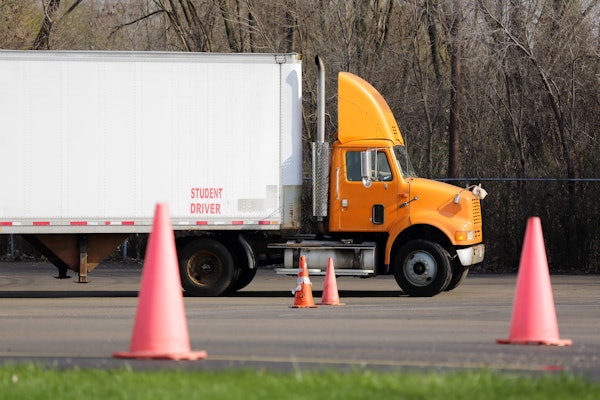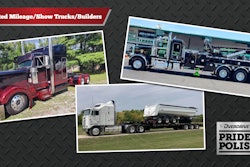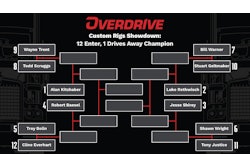Most domestic biodiesel is made from soybeans, but sunflowers, rapeseed and other stocks are also used.
Biodiesel hasn’t exactly swept the country, but it’s getting known – and used. While the 75 million gallons sold in 2005 represents only .02 percent of the 34billion gallons of petroleum-based diesel sold that year, it’s three times the amount sold in 2004, according to the National Biodiesel Board.
There’s every indication that biodiesel use will continue that fast growth. Available at 600 pumps nationwide, the fuel has received more attention in the past year than ever before, from Willie Nelson’s enthusiastic marketing in Texas to Minnesota’s struggles to implement its mandated sale. Though a few drawbacks make biodiesel less than a slam-dunk choice, it appears to be the first alternative fuel to take root in the heavy-duty industry.
“Biodiesel is the fastest growing alternative fuel,” says Amber Pearson, National Biodiesel Board spokeswoman. “It could comprise 10 percent of the diesel fuel market within the next decade or so.” Citing a U.S. Department of Energy forecast, she adds that biodiesel production is likely to double in 2006.
Biodiesel is as much as 75 percent cleaner than fossil fuels. It is inherently low in sulfur, while retaining the lubricity needed for your injectors. Made of oil derived from soybeans or other agricultural products, biodiesel can be blended with petroleum diesel with little or no modification.

The fuel has been successfully used by fleet owners, including the City of Dallas and IESI, a 780-vehicle waste management company.
Biodiesel has made inroads beyond trucking, as well. Cook-Illinois, the nation’s sixth largest private school bus operator, said last year it would switch from ultra-low sulfur diesel to a biodiesel blend. The company already fuels half its 1,600-bus fleet with 20 percent soy-based biodiesel.
Perhaps the fuel’s most widely publicized marketing effort has been Willie Nelson’s biodiesel venture – aptly named BioWillie – founded with Carl Cornelius, operator of Carl’s Corner Truck Stop near Dallas, and two other partners. The fuel is sold at Carl’s and eight other Texas locations, plus two locations in California and one each in Georgia and South Carolina. If you saw Nelson on tour this year, he arrived in your city via trucks and tour buses powered by BioWillie. The singer’s company is negotiating to sell the fuel at truck stops nationwide.
More than 85 biodiesel bills were introduced in state legislatures in 2003. Of the 33 states where such bills were considered, 10 passed some version of them, says Steve Howell of MARC-IV Consulting, which represents the National Biodiesel Board.
Most measures give supply, demand or infrastructure incentives. For example, the Illinois General Assembly recently voted to make biodiesel blends of 20 percent or higher eligible for rebates and grants.
The most aggressive state action has been in Minnesota, where a law took effect Sept. 29 requiring that all diesel sold in the state contain 2 percent biodiesel. By November, gelling problems had cropped up in Minnesota’s cold climate, even among experienced truckers using seasonal blends, says John Hausladen, president of the Minnesota Trucking Association.
Biodiesel is not inherently prone to gelling, and it can be blended to winter-friendly specifications, Hausladen says. The Minnesota problem, he says, occurred because some of the fuel, produced at three different plants, was off-spec. The gelling culprit, Hausladen says, was glycerol, commercially known as glycerine, a syrupy liquid byproduct of processed vegetable oils.
Thanks in part to lobbying by Hausladen’s association, the Minnesota law was suspended for nearly two months but went back into effect Feb. 10. The state is trying to put together a quality assurance plan that will stem such problems, Hausladen says.
Greg Greving has experienced no gelling problems in his fuel filters while running on biodiesel in another cold Midwestern state. “You need to manage your fuel just like when running straight petroleum diesel fuel,” says Greving, who uses a self-blended 2 percent mix to operate two farm trucks near Chapman, Neb. “It’s the same as using straight No. 2 with fuel heaters and additives, or running a No. 1/No. 2, 40-60 percent blend.”
“You should use tank cleaners in your fuel tanks and fill up at a truck stop where the fuel is always good,” he says. “At 2 percent to 5 percent, you’re going to see very little difference in the gelling temperature or cloud point.”
Nor has Greving had problems with injector seals or internal parts in his 1999 Caterpillar C15s. Moreover, he says, a 2 percent biodiesel blend “raises lubricity by 60 percent, which will be advantageous with the new low-sulfur fuel,” which itself reduces lubricity.
The American Trucking Associations supports alternative fuels “as long as our members can maintain the integrity of their equipment,” says President Bill Graves. ATA wants to avoid a patchwork system in which fuels won’t be available nationwide or will be unreliable because of climate differences or local regulations, Graves says.
Biodiesel costs a little more to make than it once did because biodiesel manufacturing, like all other manufacturing, uses increasingly pricey petroleum products. Yet the price difference between biodiesel and traditional diesel has dropped, thanks in part to tax incentives for producers and blenders.
The National Biodiesel Board has estimated that the cost of a diesel blend rises a penny for each percent of added biodiesel, but Pearson recently bought B20, a 20 percent blend, for only 6 cents more a gallon.
Some blends actually are cheaper than straight diesel No. 2. For example, in mid-January, BioWillie cost $1.79 a gallon, less than the national diesel average.
Biodiesel produces less particulate, carbon monoxide, and hydrocarbon than regular diesel, but more nitrogen oxide, says Howell of Marc-IV.
When straight biodiesel is burned, particulate matter is lower, but NOx levels are higher than when burning fossil diesel, Detroit Diesel says. Small concentrations such as 5 percent biodiesel, however, minimally affect emissions.
Burning petroleum-based fuels is a one-way process, and an ugly one to boot. Besides water vapor, it adds carbon dioxide, carbon monoxide, particulate and NOx into the atmosphere, but never retrieves them.
The carbon dioxide and water vapor in biodiesel exhaust are recycled when plants photosynthesize them back into natural sugars. Biodiesel also is a renewable, home-grown resource that won’t enrich foreign countries.
Don’t confuse biodiesel with a semi-solid leftover normally hauled away to waste centers. While many hobbyists and local operations produce biodiesel from restaurant cooking grease, virtually all of today’s commercially available biodiesel is made from rapeseed, sunflower seed, soybeans or palm oil.
Good quality biodiesel is a highly refined product that undergoes major chemical changes before it is sold, just as regular diesel fuel is derived from heavy, dark crude oil.
Greving’s biodiesel contains 2 percent soy-based fuel blended with No. 2 diesel. The soy oil, purchased from the same local fuel dealer as the other fuel for his farm, comes in 250-gallon totes.
A big part of Greving’s trucking operation is delivering farm equipment. A member of the Nebraska Soybean Checkoff Board, he says many of his customers grow soybeans and notice the “Powered by Soy Biodiesel” written on his truck. “The sign is a great conversation starter when we deliver to their farms,” he says.
Regional economic incentives, national environmental concerns and biodiesel’s long-term promise as a renewable resource could make it an ever more viable fuel. As its use spreads and gelling problems are minimized, users likely will find little difference in engine hardware and maintenance.
BIODIESEL
PROS
Reduces emissions.
Reduces dependence on imported fuel.
Stimulates domestic farm production.
Renewable resource.
CONS
Some blends can clog fuel filters in cold climates.
Slightly decreases fuel efficiency.
Price tends to be higher.
Engine warranties don’t cover biodiesel-related problems.
ENGINE MAKERS ACCEPT BIODIESEL – UP TO A POINT
Engine manufacturers approve biodiesel use, as long as you select an approved fuel. The major applicable standard is ASTM D6751, which is similar to regular diesel.
Any engine failure attributed to biodiesel use, though, will not be covered by the product warranty – but then again neither are failures caused by regular diesel fuel.
Beginning Oct. 15 of this year, 80 percent of diesel fuel sold in the United States must be ultra-low-sulfur, defined as having no more sulfur than 15 parts per million. Any biodiesel blend will have to conform to the same standard. Engine makers continue to research performance with today’s fuel and with ultra-low-sulfur diesel.
CATERPILLAR
Caterpillar service literature says the quality of esterification done in the refining process is critically important because the base ingredients, such as soybean oil or rapeseed oil, may gel in the fuel tank and the crankcase. Cat says it’s the user’s responsibility to ensure the fuel is allowed by regulatory agencies.
The company allows biodiesel fuels meeting ASTM D6751 or EN 14214 and allows blending even up to 30 percent. Cat’s recommendations include two technical specifications that you can review with your fuel supplier. Cat also recommends that biodiesel users analyze their oil to determine whether change intervals need to be more frequent. Some biodiesel byproducts may affect viscosity and total base number.
Cat finds that biodiesel produces 5 percent to 7 percent less energy per gallon, so even a 2 percent blend could hurt your fuel economy by a tiny percentage.
The company also is not certain biodiesel is compatible with hoses and seals in the fuel system, so monitor their condition.
CUMMINS
Cummins approves use of 5 percent biodiesel. “No modification to the engine is needed to enable it to operate on B5 biodiesel, and no impact on engine performance, durability or maintenance is anticipated,” says Kevan Browne of Cummins.
That’s true for 2007 engines as well, the company says. “There are indications that particulate matter and hydrocarbons may be reduced, but NOx may be marginally increased,” Browne says.
While Cummins is exploring the possibility of approving higher concentrations, it advises users not to go beyond 5 percent in the meantime.
DETROIT DIESEL
Biodiesel “is an integral part of our fuel strategy,” says
a Detroit Diesel service memo. The company recommends fuel made from rapeseed, canola oil or soybeans, but not from other sources. The fuel must meet ASTM D6751 and can be blended up to 5 percent.
Any fuel must meet the detailed specifications listed in the company’s publication 7SE270 (0401). Because biodiesel is less stable than regular diesel, “care must be exercised in storage and handling to prevent spoilage, oxidation and waxing,” the memo says. Biodiesel is more prone to the growth of microbes, so you may need to add a biocide if using a storage tank, the company says. The tank also may need to be heated to prevent clogged filters.
Like Caterpillar, Detroit says biodiesel has a slightly reduced energy content.
VOLVO AND MACK
Volvo and Mack “strongly support the use of renewable fuels” and approve biodiesel blends up to 5 percent for current and 2007 engines, says Dave McKenna, powertrain product manager for Mack, which is part of the Volvo Group.
“We are working with the Engine Manufacturers Association to address concerns about biodiesel stability and cold weather operation, with a goal to establish an ASTM specification to control biodiesel fuels,” McKenna says. “However, at the relatively low percentages (B2 and B5) that are approved, these issues should be minimal. Widespread availability of biodiesel to support broad use must also be addressed.”
IN THIS CORNER, THE FEATHERWEIGHT CONTENDER
Another diesel alternative is natural gas, which has been successfully used in large engines for many years. One big difference between it and biodiesel is efficiency. A natural gas engine is less efficient than a diesel because it must use less compression. Today’s largest gas-operating trucks are Class 6 and 7 vehicles that return to a home base every night.
Cummins is the only major American company making Class 8 natural gas engines through Cummins Westport – a joint alternative-engine venture of Cummins Inc. and Westport Innovations, based in British Columbia – but they are not currently on the market.
The typical natural gas user is a utility or trash fleet operating around a city with underground gas mains. The engine is not much more expensive than a diesel, though spark ignition may require more frequent maintenance than modern diesel injection. The net fuel cost usually is lower, with the absence of tax being a major factor.
The main incentive for fleets, so far, has been environmental. “Natural gas vehicles offer a clear emissions advantage relative to NOx and particulate matter,” says Jeff Campbell, director of product marketing for Cummins Westport. “Many fleets operating today are in place as a result of this clean fuel option, their decision driven by mandates and incentives.”
Compared to diesel, natural gas produces minimal sooting and lower emissions of hydrocarbons, carbon monoxide and carbon dioxide. Most of the exhaust is water.
The many kinds of natural gas fuel systems include those that use diesel with a small injector to ignite the gas, making compression ignition and higher efficiency feasible.
Cummins’ current model, the Westport ISL, uses what the company calls Lean Burn Spark Ignited technology, Campbell says. This engine has spark plugs, a complete ignition system and a throttle similar to a gasoline engine, but runs lean, taking in more air than required for combustion like a diesel.
In 2007, it will be replaced by the ISL G, which Campbell describes as a “cooled EGR, spark-ignited natural gas engine.” The engine will ingest exactly the amount of air needed for combustion, like a gasoline engine. Its cooled exhaust gas recycling will replace the excess air used in the present engine.
It, too, will have spark plugs, an ignition system and a throttle. It also will have a three-way catalyst, like that used in cars, to reduce emissions. This will improve fuel efficiency.
The technology will meet not only 2007, but 2010 emissions standards.
“All Cummins Westport natural gas engines can use compressed or liquefied natural gas,” Campbell says. “Typically, a fueling station is installed at the fleet location and connected to the local gas utility, or in the case of LNG, delivered to the site by truck.”
One downside of gas is that it’s harder to carry on the truck. It must be stored in limited quantity in high pressure tanks, or liquefied in tanks operating under high pressure and kept cold with heavy insulation.
Also, supplying fuel can be a major issue. For that reason, gas utilities were among the first users. At present, the very limited availability of natural gas makes it feasible only for good-sized fleets.
Natural gas
PROS
Burns cleaner than diesel.
Costs less than diesel, depending on infrastructure.
Does not gel in cold climates.
CONS
Difficult to carry as fuel.
No refueling network exists.
The engine is less efficient than a diesel.
–Lance Orr and Sean Kelley contributed to this story.










